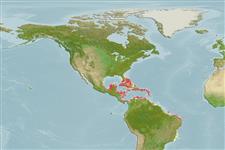Actinopterygii (ray-finned fishes) >
Perciformes (Perch-likes) >
Gobiidae (Gobies) > Gobiinae
Etymology: Bathygobius: Greek, bathys = deep + Latin, gobius = gudgeon (Ref. 45335).
Environment / Climate / Range
Ecology
Marine; demersal. Tropical, preferred ?; 32°N -
Western Atlantic: Bermuda, Florida (USA), and the Bahamas to northern South America.
Size / Weight / Age
Maturity: Lm ? range ? - ? cm
Max length : 7.5 cm TL male/unsexed; (Ref. 7251)
Short description
Morphology | Morphometrics
Dorsal
spines
(total): 6 - 7;
Dorsal
soft rays
(total): 9;
Anal
spines: 1;
Anal
soft rays: 8. This species is distinguished by the following characters: 16-17 pectoral fin rays (rarely 15 or 18); 31-36 lateral scale rows; upper jaw length 11.1-15.0 % SL; predorsal squamation extending anteriorly to vertical through posterior margin of preopercle, sometimes slightly beyond this point; body variously covered in dark blotches, sometimes loosely forming 6-7 diffuse dark blotches of varying size down body, trunk typically with no apparent diagnostic pattern of pigment (Ref. 85559).
Inhabits tide pools and shore waters, including mangrove areas (around muddy substrate near mangrove roots) and sheltered seagrass beds (rock and turtle grass) (Ref. 7251, 85559).
Life cycle and mating behavior
Maturity | Reproduction | Spawning | Eggs | Fecundity | Larvae
Robins, C.R. and G.C. Ray, 1986. A field guide to Atlantic coast fishes of North America. Houghton Mifflin Company, Boston, U.S.A. 354 p. (Ref. 7251)
IUCN Red List Status (Ref. 115185)
CITES (Ref. 94142)
Not Evaluated
Threat to humans
Harmless
Human uses
More information
Age/SizeGrowthLength-weightLength-lengthLength-frequenciesMorphometricsMorphologyLarvaeLarval dynamicsRecruitmentAbundance
ReferencesAquacultureAquaculture profileStrainsGeneticsAllele frequenciesHeritabilityDiseasesProcessingMass conversion
Tools
Special reports
Download XML
Internet sources
